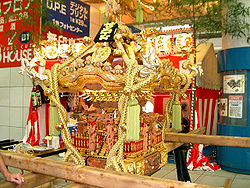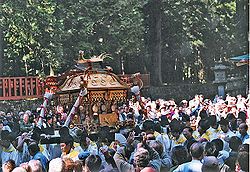
Mikoshi
Encyclopedia


Japan
Japan is an island nation in East Asia. Located in the Pacific Ocean, it lies to the east of the Sea of Japan, China, North Korea, South Korea and Russia, stretching from the Sea of Okhotsk in the north to the East China Sea and Taiwan in the south...
while moving between main shrine and temporary shrine during a festival or when moving to a new shrine. Often, the mikoshi resembles a miniature building, with pillars, walls, a roof, a veranda and a railing.
Shapes
Typical shapes are rectangles, hexagons, and octagons. The body, which stands on two or four poles (for carrying), is usually lavishly decorated, and the roof might hold a carving of a phoenixPhoenix (mythology)
The phoenix or phenix is a mythical sacred firebird that can be found in the mythologies of the Arabian, Persians, Greeks, Romans, Egyptians, Chinese, Indian and Phoenicians....
.
Festival and Flow
During a matsuri (Japanese festival) involving a mikoshi, people bear the mikoshi on their shoulders by means of two, four (or sometimes, rarely, six) poles. They bring the mikoshi from the shrine, carry it around the neighborhoods that worship at the shrine, and in many cases leave it in a designated area, resting on blocks called uma (horse), for a time before returning it to the shrine. Some shrines have the custom of dipping the mikoshi in the water of a nearby lake, river or ocean (this practice is called o-hamaori). At some festivals, the people who bear the mikoshi wave it wildly from side to side to "amuse" the deity (kamiKami
is the Japanese word for the spirits, natural forces, or essence in the Shinto faith. Although the word is sometimes translated as "god" or "deity", some Shinto scholars argue that such a translation can cause a misunderstanding of the term...
) inside.
Kind of shouldering types
The most common method of shouldering in Japan is "Hira-katsugi(Normal style) | 平担ぎ"The shout is "wasshoi | wa syoi | わっしょい"
and the bearers do not sway the mikoshi.
One famous way of shouldering is "Edomae style | 江戸前" seen by Asakusa Sanja Festival etc.
The shout is "say ya, soi ya, sah, sorya...etc"
The mikoshi is swayed rapidly, up and down and a little to the right and left.
http://www.youtube.com/watch?v=d4-PRjCedFE
"Dokkoi | ドッコイ " is seen in Shonan in Kanagawa Prefecture.
This shouldering style usually uses two poles. The mikoshi is moved up and down rhythmically, and more slowly than in the "Edomae style"
One shout is "dokkoi dokkoi dokkoi sorya" and there is a song called a "Jink | lively song."
http://www.youtube.com/watch?v=fJCxRngg95Y
Odawara (next to the Hakone) "Odawara style | 小田原担ぎ "
This is a peculiar way of shouldering in which multiple mikoshis meet and run (Holy Dash).
The shout is "oisah;korasah/koryasah." and there is a song called a "Kiyari | "log-carriers(fishermans) chant"
The bearers do not sway the mikoshi.
In this "united" style, the mikoshi uses the full width of the road, moving from side to side and turning corners at full speed.
It looks like the burnout
Burnout
Burnout or burn-out may refer to:*Burnout , a psychological term for a syndrome characterized by long-term exhaustion and diminished interest, especially in one's career*Burnout , when a vehicle's tires are spun so they smoke...
and drift
Drift
- Film and literature :* Drift , a 2002 Doctor Who novel* Drift , a series of Japanese films written and directed by Futoshi Jinno* Drift, 2007 experimental short film by Max Hattler* Drift , a fictional character...
of a car.
http://www.youtube.com/watch?v=3YyjVH7FVuw
Roots
Ark
Ark is a Latin-based word that means a "box" or container. Ark may refer to:-Religion:* Ark , a cabinet used to store a synagogue's Torah scroll* Ark of the Covenant, the consecrated container for the tablets of the Ten Commandments...
".
Actually, mikoshi and the ark of the covenant do not have much in common. They differ in production and decoration (a phoenix or a crane being very different from cherubim.)
- Other Commonality: There are some points similar to the Jewish faith. Ise Jingu drums ("Jingu" means Greate-shrine) are called "Zion Drums" and GionGionis a district of Kyoto, Japan, originally developed in the Middle Ages, in front of Yasaka Shrine. The district was built to accommodate the needs of travelers and visitors to the shrine...
YasakaYasakaYasaka may refer to:* Yasaka, Nagano, Japan * Yasaka, Shimane, Japan * Yasaka, Kyoto, Japan * Yasaka Shrine in Kyoto, Japan...
shrine to faith. In the Yasaka and Ise Shrine surroundings, such as amulets of the emblem of David. In addition, Yashashkar (or Shasshu, Cal) is similar phonetically to Issacar, יִשָּׂשׁכָר (Aramaic), one of the "ten lost tribes" of Israel.
::Refer to Japanese version for details.
http://en.wikipedia.org/wiki/Japanese-Jewish_Common_Ancestor_Theory
First use
A mikoshi was believed to have been first used to transport HachimanHachiman
In Japanese mythology, is the Japanese syncretic god of archery and war, incorporating elements from both Shinto and Buddhism. Although often called the god of war, he is more correctly defined as the tutelary god of warriors. He is also divine protector of Japan and the Japanese people...
to Tōdai-ji
Todai-ji
, is a Buddhist temple complex located in the city of Nara, Japan. Its Great Buddha Hall , the largest wooden building in the world, houses the world's largest bronze statue of the Buddha Vairocana, known in Japanese simply as Daibutsu . The temple also serves as the Japanese headquarters of the ...
temple from Usa Shrine
Usa Shrine
, also known as , is a Shinto shrine in the city of Usa in Ōita Prefecture in Japan. Emperor Ojin, who was deified as Hachiman-jin , is said to be enshrined in all the sites dedicated to him; and the first and earliest of these was at Usa in the early 8th century...
八幡宇佐宮御託宣集 (This "Usa" is Not America) in 749.
External links
- Mikoshi Photos of Shinto shrine (English version)
- Mikoshi Festival

